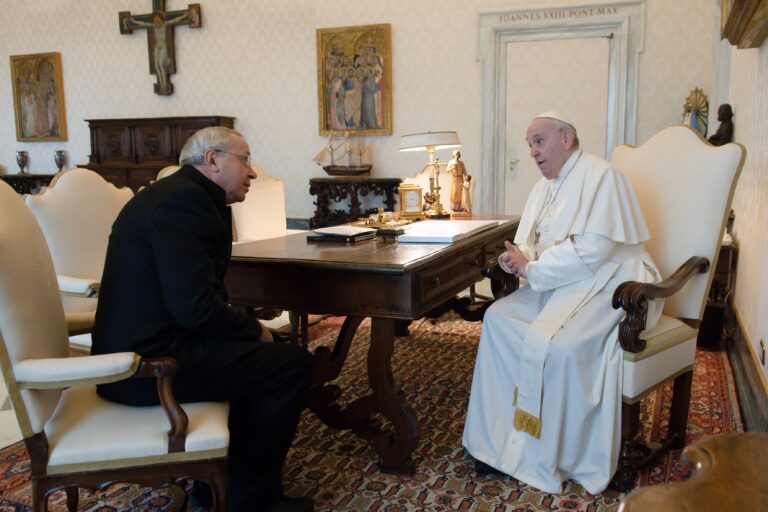The sorry tale of the alleged systematic abuse perpetrated by Slovenian Jesuit Fr Marco Rupnik is a familiar story for the Church. Only a few months after an extensive report on Jean Vanier was released, Rupnik stands accused of using spiritual means for perverse ends.
A number of nuns came forward last year, alleging that the prominent Jesuit used his position of authority in the Loyola community he founded to sexually, psychologically and spiritually abuse them. He was also briefly excommunicated in 2020, for attempting to sacramentally absolve a woman after a sexual encounter with her, a major crime in the Church’s canon law. Since then, the Society of Jesus have received further complaints of abuse spanning decades.
As with Vanier, the founder of charity L’Arche, Fr Rupnik’s private perversion was combined with public prominence and a reputation for spiritual insight. Fr Rupnik founded his own community of nuns in Slovenia, but really came to fame as an artist, founding an artistic centre in Rome. Many of his paintings and mosaics now adorn the walls of churches, Catholic universities and Vatican establishments – including the Irish College in Rome and the basilica in Lourdes.
He was permitted to design the logo for the Vatican-sponsored 2022 World Meeting of Families even after his excommunication and two of Rupnik’s icons have been used as spiritual resources for the present Universal Synod 2023-24. These have since been removed quietly.
Allegations
Now that these allegations have emerged, the question has arisen – what to do with his art? Already calls have emerged for Fr Rupnik’s creations to be stripped from churches and Catholic institutions. As this paper goes to print, bishops in France are organising a committee that will include abuse survivors and victims to discuss whether to remove the alleged abuser’s artworks from the holy site. For a site so closely associated with healing, for many victims, seeing his work there is a painful reminder of deep wounds.
For Gina Barthel, a clerical abuse survivor from Minnesota, US, “his artwork should be removed, as a testimony to the entire Church, and as a witness, that there are consequences to perpetrating abuse”. “There is a difference between clergy who have been accused and clergy who have been found guilty. And he is accused of some really terrible things, but he has also already been found guilty of a serious and disturbing canonical crime. So it should come down,” she told The Pillar.
Survivor
She added that, as a survivor of clerical abuse, it would not be possible for her to pray in a chapel designed by Rupnik. “I think the most virtuous path would be to take it down,” Ms Barthel said. “If that’s not possible in a particular circumstance for some reason, you should make a statement about that, and make a donation on behalf of victims. I guess that would be the next best, but that would sadden my heart.”
However, the Slovenian bishops have pushed back against removing Rupnik’s art. In a statement from December 22, 2022, they said “The news about the abuses committed by Fr Rupnik have shocked the Slovenian and global public. “We have known Fr Rupnik as an outstanding artist and insightful spiritual leader who has marked many personal lives and communities and created many works of art and spiritual literature.” They say they “understand that many of you are hurt by this news and that you are wondering whether or not it should all be thrown away.”
“We beg you,” they say, “with this tragic realisation in mind, to distinguish his unacceptable and reprehensible actions from his extraordinary spiritual and artistic accomplishments in mosaics and other areas.” Already the debate has begun, with other voices adding their two cents’ worth.
The National Catholic Register, OSV News, Pillar Catholic and others have been debating in columns and articles the pros and cons to removing Fr Rupnik’s art. The two main positions emerging are those in favour of removing Rupnik’s art due to the moral and psychological harm it causes, and those who favour keeping it due to its artistic merit, while making clear the sins of its creator.
As almost all these columns make clear, this is not a new conundrum for the Church or for wider society. Some Church artists have been saints, but many others are deeply flawed sinners. We don’t have to look too far back for examples. Eric Gill is a case in point; his relief sculptures still stand in Westminster Cathedral and numerous other public buildings around the UK. But as became clear after he died, he committed terrible acts of abuse.
Though not on the same scale, Catholic novelist Graham Greene wrote some of the best works of fiction of the 20th Century while being an adulterer. Caravaggio, whose famous painting Taking of Christ is housed in Ireland’s National Gallery, killed a man. Raphael and Michelangelo were great Church artists, whose works adorn the Vatican, but neither of them saints. Their works of art have, so far, outlasted their reputations as fallen men who led, in some cases, terrible lives.
What we have been left with is the beauty of their creations, a beauty which gives evidence of the silver fountain from which all beauty, truth and goodness springs – God. If it is possible for their works to outlast their reputations, could it be that Rupnik’s art will outlast his? That certainly could be the case, as already many will gaze on his mosaics in contemplation of God without any sense of the human creator. We need only look to the Bible to know that God made use of sinful men to effect his plan of salvation.
However, Rupnik’s case is complicated further because he has become the effective “image-maker” of the Church in his time, as artists Andrew and Gwyneth Thompson-Briggs point out in the National Catholic Register. Even here the situation is not unprecedented.
The 17th Century painter Gianlorenzo Bernini was effectively the Church’s official artist in his time. He too became embroiled in scandal after he attempted to kill his brother for taking up with his own mistress and had her face marred with a razorblade. The case died down – with the help of the Pope – and now his art charms and beguiles us.
Heinous
But as the contemporary artist Gwyneth Thompson Briggs points out, Rupnik is not accused of a crime of passion. He stands accused of something much more heinous – taking advantage of his position as a priest and a man of influence to systematically abuse a number of men and women.
Does the reprehensible nature of his crimes require a sterner sentence, especially at a time when the Church is grappling with the revelations of abuse? Perhaps this is so and it’s certainly the argument eloquently expressed by Ms Barthel.
The difficulty with removing Rupnik’s works entirely is that, once created and offered up to the audience, they are no longer simply his. He has divested himself of the ideas, offering them up for the consideration of others. If there is something sinister in the art itself, something that would harm the viewer, then it would make for a strong argument for destroying or removing his creations. But if that isn’t the case, should the innocent admirers of his work no longer appreciate the beauty in them?
Or can it be that they can see the beauty and know the awful truth? A stern sentence for his art doesn’t necessarily mean that there is only one option. Perhaps, as the editor of OSV News Fr Patrick Briscoe suggests, his art could be strategically defaced, a reminder of Rupnik’s crimes.
Other suggestions offered by Fr Briscoe are that where his art is displayed, a biography and explanation should be included, or the profits associated with his art should be donated to charities for victims of abuse.
Arguments
While most arguments have revolved around the artistic merit versus psychological and moral harm, Fr Briscoe’s hints at a third position. This position sees a danger in removing the works of a sinner, even one accused of terrible crimes like Fr Rupnik. The danger is that by removing the paintings or mosaics, we are erasing a powerful reminder of the rot which has so afflicted the Church and the victims, in this case sexual abuse.
It is akin to the conundrum felt by Americans when it comes to removing statues of Confederates from public places. The act of removing them is a ritual, intended to demonstrate that the racism for which they stood is no longer acceptable. It can be a powerful gesture; but also one quickly forgotten. You remove them once and they are gone from the public eye. You run the risk of forgetting them.
Whereas if you kept the statues in place, you ensure that the public is always aware of the dark side of the American story without belabouring the point. Fr Rupnik’s art could serve a similar function. By keeping it at the heart of our churches, we can place before the casual Massgoer a terrible part of our Church’s past.
It is hard to keep these heinous acts in mind for the average man or woman as they were so awful, and it is hard to address them regularly as a priest without seeming to belabour an innocent majority. Fr Rupnik’s art could serve as just such a reminder.
In a way, I think it would be a Christian response to the problem of his evil. As the Gospels show in particular, God has taken sin into account in the plan of salvation. It was Judas Iscariot’s betrayal that enables our salvation and every year the Passion is recounted in Churches across the world with Judas at its centre.
Scourge
If what is alleged about Fr Rupnik is true, then his betrayal, his sins, strike right at the heart of the Church, another example of the scourge of abuse in the midst of what is meant to be a holy institution.
We can no more remove the sin from the Church’s past than we could erase the damage it has done to the survivors and victims. Instead, we could keep it before our eyes in a manner that is not self-flagellating, but honest and sincere.
We can pray for forgiveness as we meditate on the artwork of an alleged perpetrator; we can pray for healing for the victims. Perhaps we can, in other words, recover good from the evil acts Fr Rupnik stands accused of. Regardless, as French Bishop Jean-Marc Micas said in a statement regarding Lourdes, the anguish of abuse victims “is great before the mosaics of Fr Rupnik in this very place: We cannot ignore it”.
Ruadhán Jones is a journalist for The Irish Catholic.



